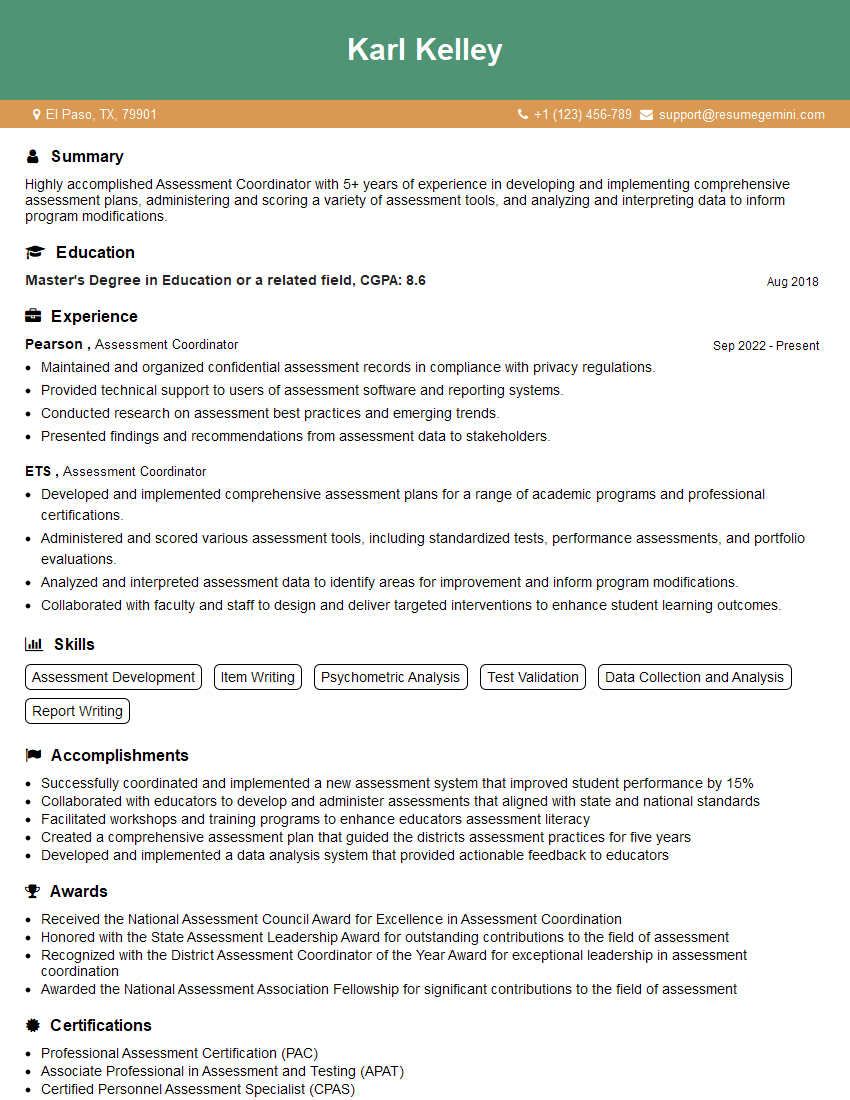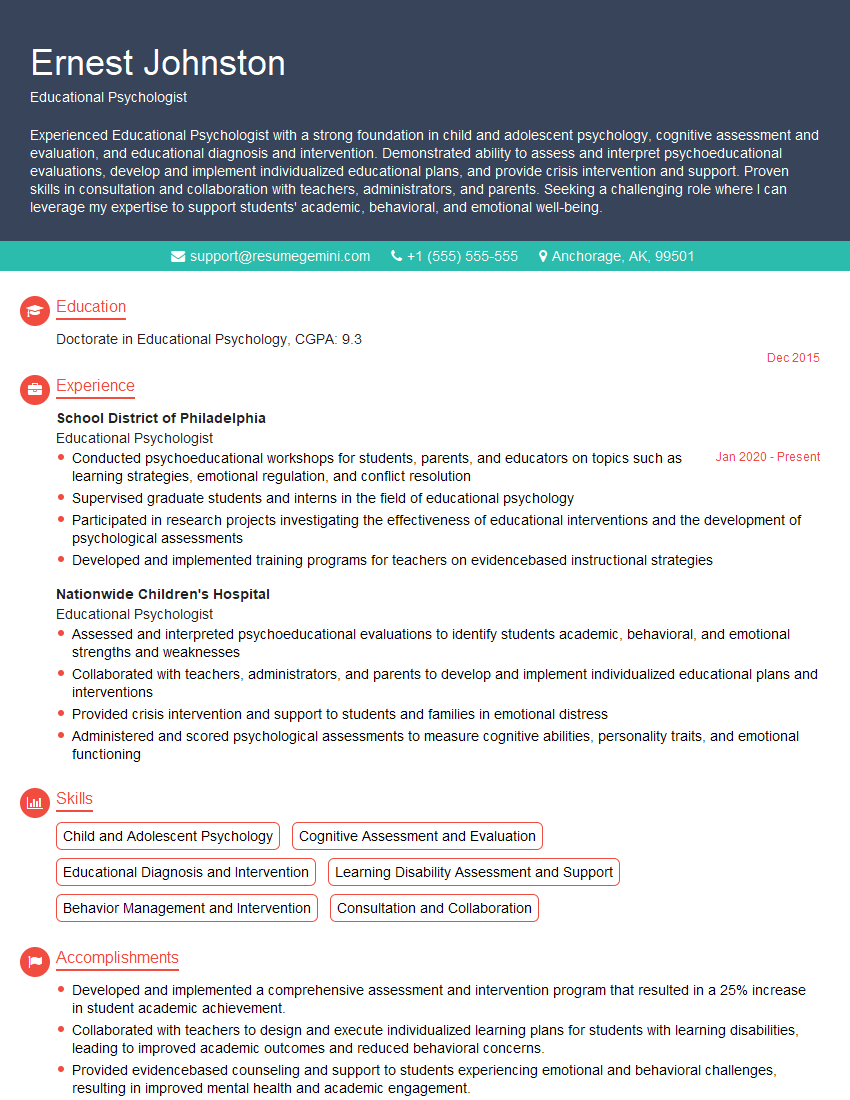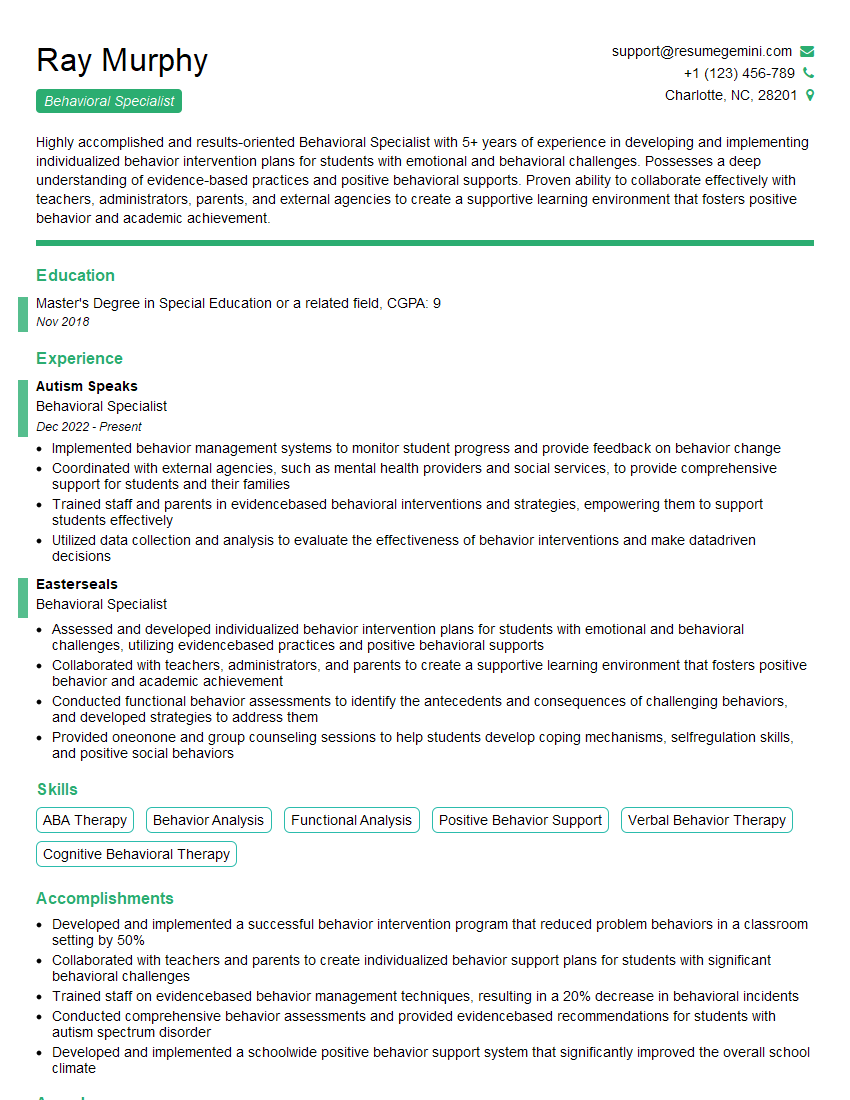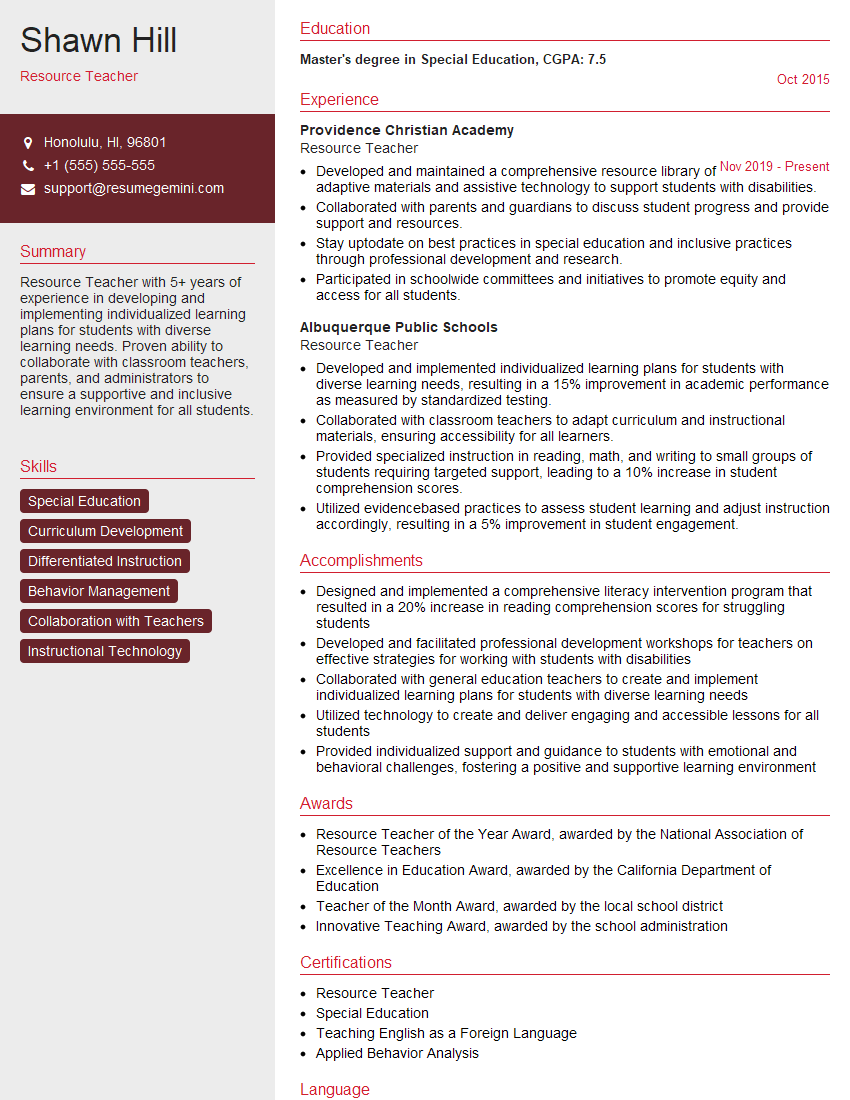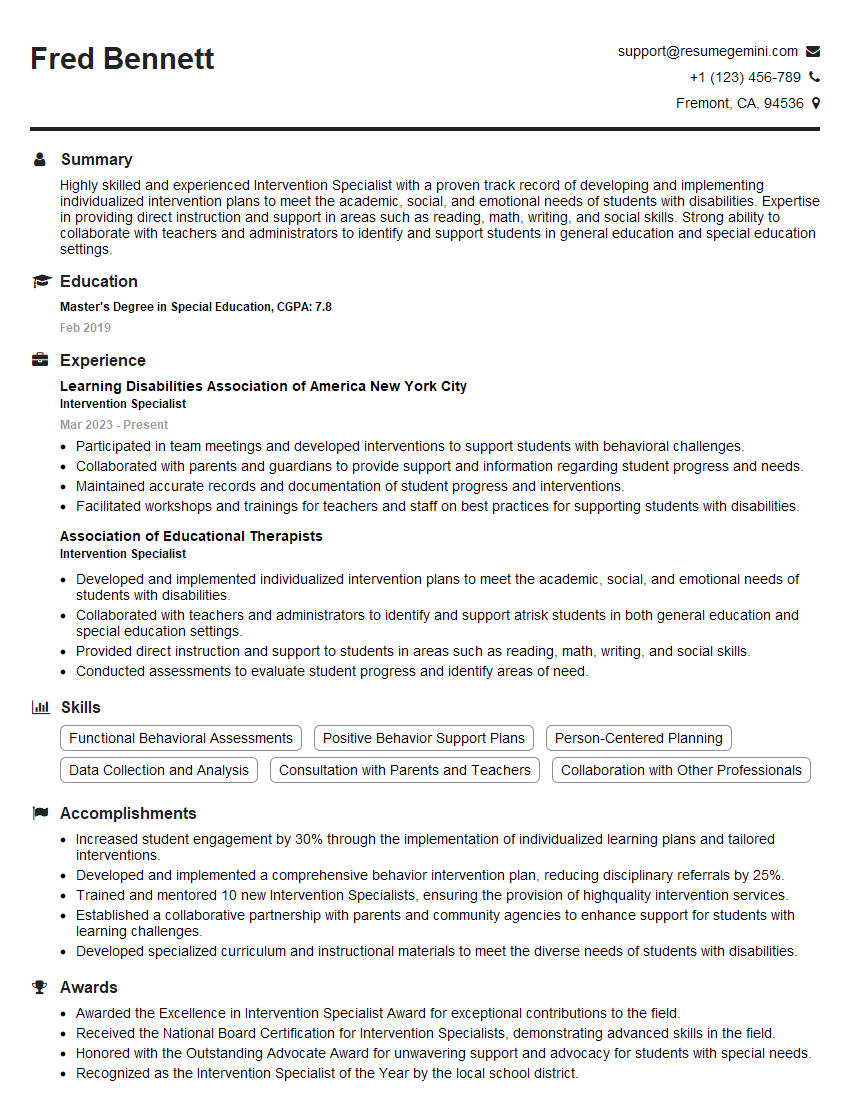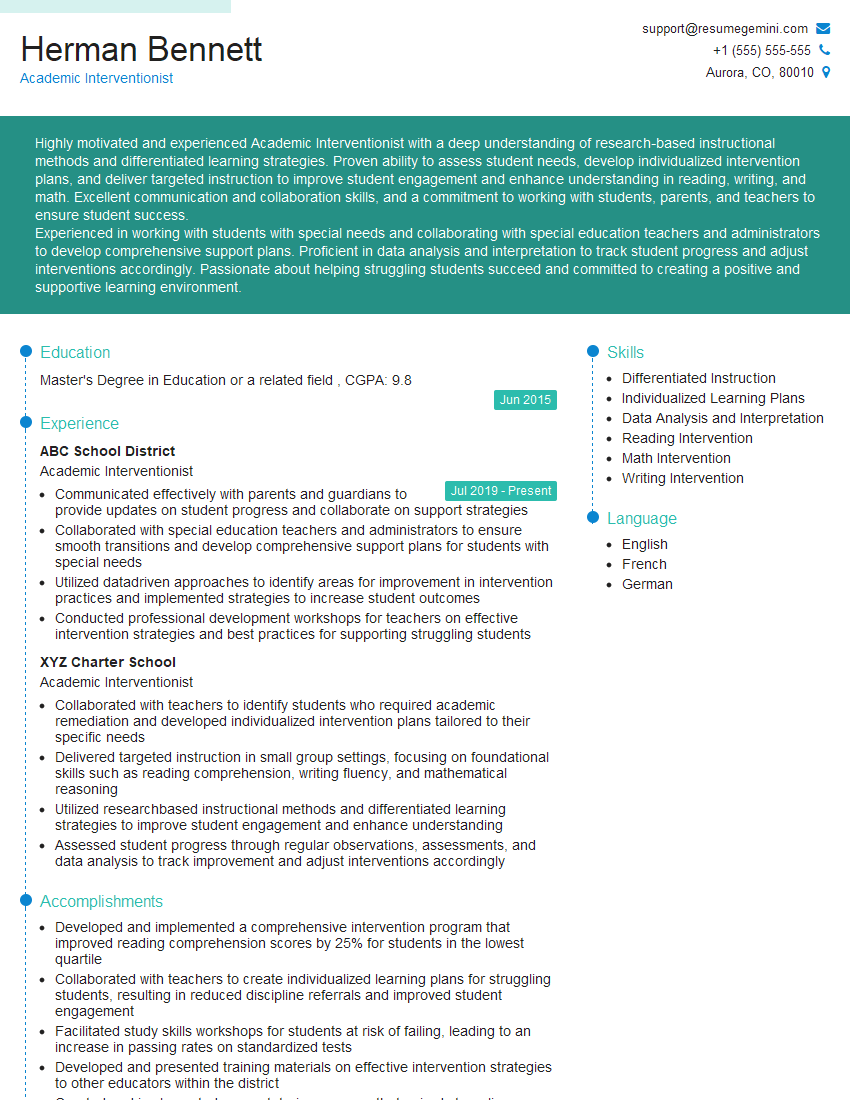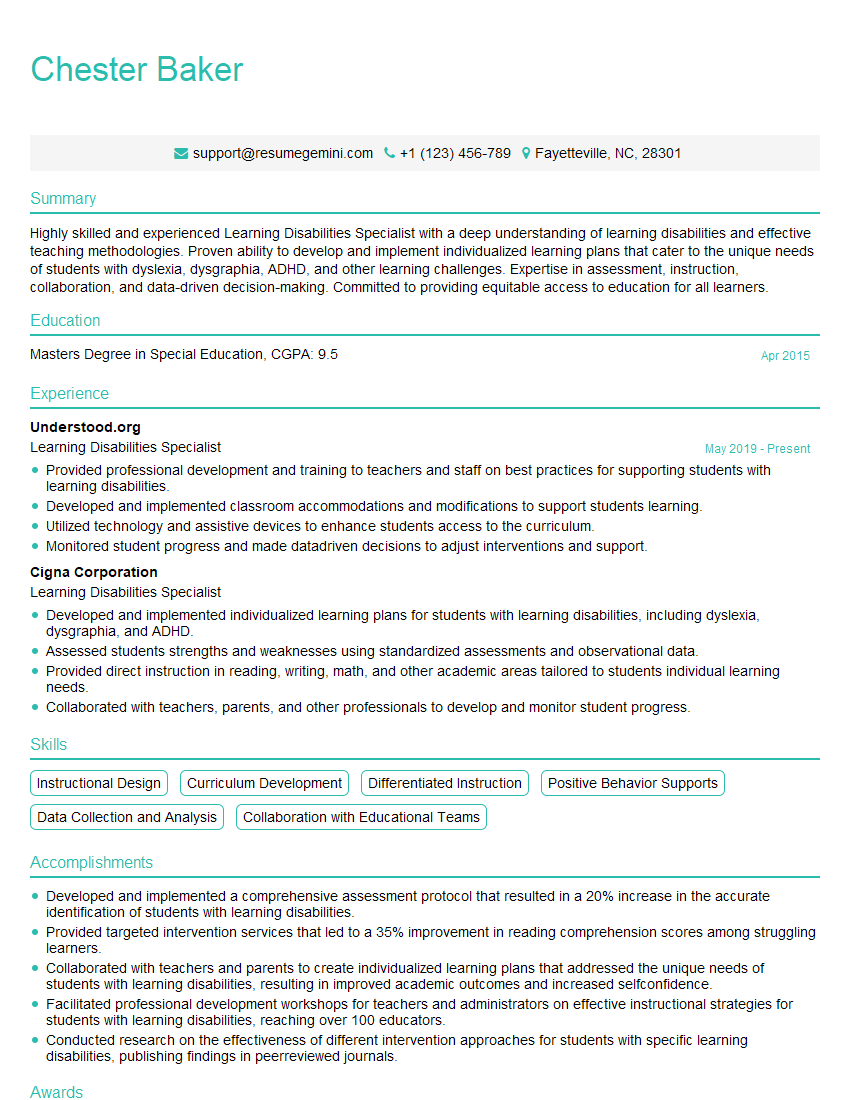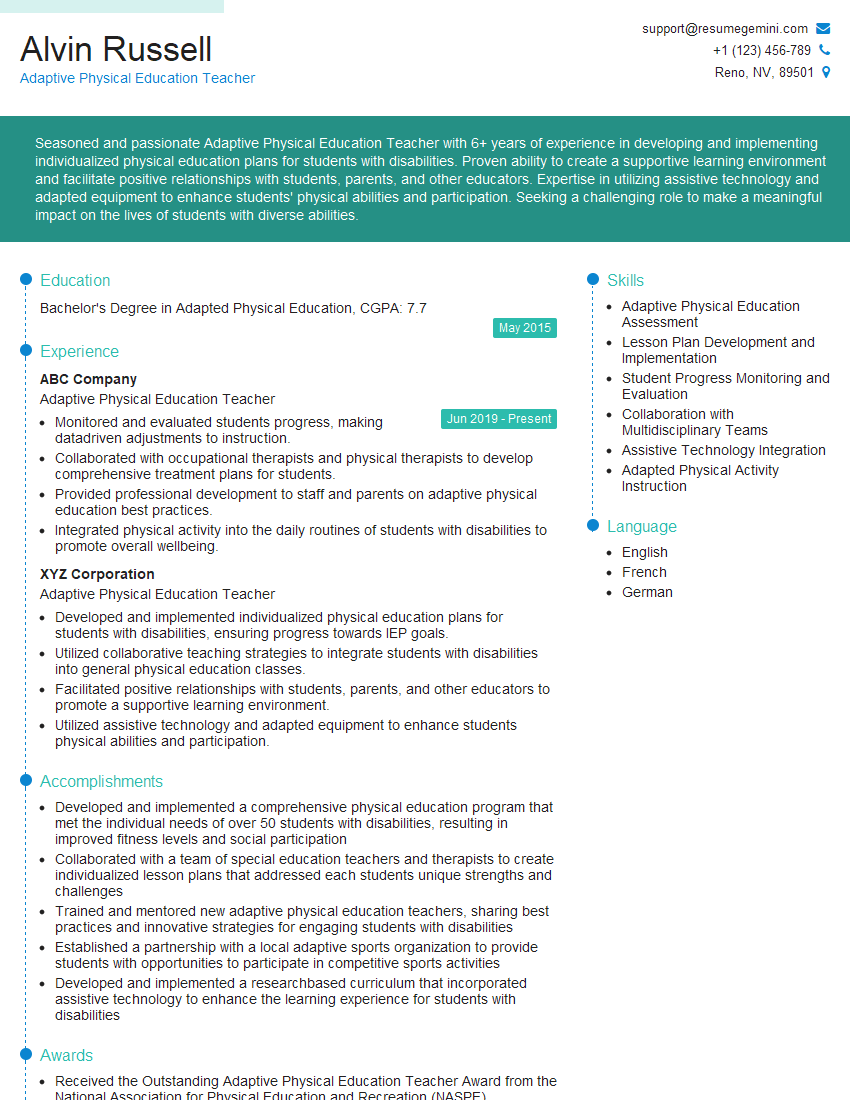Interviews are opportunities to demonstrate your expertise, and this guide is here to help you shine. Explore the essential Learning Disability Evaluation interview questions that employers frequently ask, paired with strategies for crafting responses that set you apart from the competition.
Questions Asked in Learning Disability Evaluation Interview
Q 1. Describe the process of conducting a comprehensive learning disability evaluation.
A comprehensive learning disability evaluation is a multifaceted process aimed at identifying the presence and nature of a learning disability. It’s not a single test but a series of assessments designed to provide a complete picture of a student’s strengths and weaknesses.
- Referral and Background Information Gathering: This begins with a referral, often from a teacher or parent, expressing concerns about a student’s academic performance. We then gather detailed background information, including academic history, medical history, and family history.
- Intelligence Testing: We use standardized intelligence tests, such as the Wechsler Intelligence Scale for Children (WISC), to determine a student’s overall cognitive abilities. This helps establish a baseline for comparing academic achievement.
- Achievement Testing: Standardized achievement tests, like the Woodcock-Johnson IV, measure a student’s actual academic skills in areas like reading, math, and writing. This allows us to compare their performance to their peers.
- Processing Speed Assessments: These tests assess how quickly a student processes information. Slow processing speed can significantly impact learning.
- Oral Language Assessment: We evaluate oral language skills, including receptive and expressive language, as language is foundational to learning.
- Behavioral Observations: Observing the student in the classroom and other settings provides valuable insights into their learning behaviors and challenges.
- Review of Educational Records: Examining school records, including report cards and teacher notes, provides a historical perspective on the student’s academic progress.
- Integration and Report Writing: Finally, we integrate all the assessment data to form a comprehensive understanding of the student’s learning profile and write a detailed report with recommendations.
For example, a student might score highly on an intelligence test but significantly lower on reading achievement tests, suggesting a discrepancy indicative of a reading disability like dyslexia.
Q 2. What are the key differences between dyslexia, dysgraphia, and dyscalculia?
Dyslexia, dysgraphia, and dyscalculia are all specific learning disabilities that affect different academic areas. While they can co-occur, they are distinct conditions.
- Dyslexia: Primarily affects reading and spelling. Individuals with dyslexia may struggle with phonological awareness (the ability to hear and manipulate sounds in language), decoding (sounding out words), and fluency (reading smoothly and accurately). Think of it like a disruption in the brain’s ability to process written language.
- Dysgraphia: Impacts writing abilities. Students with dysgraphia may struggle with handwriting legibility, spelling, organization of written work, and overall writing fluency. They might have difficulty with fine motor skills required for writing or struggle to put their thoughts on paper effectively. It’s like the connection between brain and hand isn’t working smoothly.
- Dyscalculia: Affects math abilities. Students with dyscalculia may struggle with number sense, memorizing math facts, performing calculations, and understanding math concepts. They might confuse numbers, have difficulty with spatial reasoning related to math, or struggle to apply mathematical concepts to real-world situations. Imagine a difficulty with the brain’s numerical processing center.
For instance, a child might be diagnosed with dyslexia if they struggle to read despite having average or above-average intelligence, while another child might be diagnosed with dysgraphia if they have difficulty writing even simple sentences, despite understanding the concepts.
Q 3. Explain the role of adaptive testing in learning disability assessments.
Adaptive testing is a crucial aspect of learning disability assessments because it tailors the assessment to the individual’s ability level. Unlike fixed-length tests, adaptive tests adjust the difficulty of questions based on the student’s responses.
If a student answers a question correctly, the next question will be more challenging. Conversely, if they answer incorrectly, the next question will be easier. This ensures that the test accurately measures the student’s abilities within their specific range, providing a more precise assessment than a standardized test with a fixed difficulty level. This approach is particularly valuable for students with suspected learning disabilities because it avoids frustration caused by overly difficult questions and provides a more efficient use of testing time.
A classic example is computerized adaptive testing (CAT) for cognitive abilities, where a system automatically adjusts the difficulty of each successive question based on the respondent’s previous answers, allowing for more accurate and efficient assessment.
Q 4. What are some common cognitive assessments used in learning disability evaluations?
Many cognitive assessments are used in learning disability evaluations, each targeting different cognitive skills.
- Wechsler Intelligence Scale for Children (WISC): Measures overall cognitive ability and provides subtest scores that identify specific cognitive strengths and weaknesses (e.g., verbal comprehension, perceptual reasoning, processing speed).
- Woodcock-Johnson IV Tests of Cognitive Abilities: Similar to the WISC, it assesses various cognitive abilities, offering detailed information about cognitive processing.
- Kaufman Assessment Battery for Children (KABC-II): Another comprehensive intelligence test that focuses on processing abilities and fluid reasoning.
- Test of Nonverbal Intelligence (TONI-4): Useful for assessing intelligence in students with language impairments.
- NEPSY-II: A neuropsychological test battery designed to evaluate a range of neurocognitive functions relevant to learning and behavior.
The choice of assessment depends on the specific concerns and the student’s age and abilities. For example, if a student struggles with reading comprehension, the evaluator might use subtests from the WISC or Woodcock-Johnson to further investigate underlying cognitive processing issues like verbal comprehension or working memory.
Q 5. How do you interpret results from standardized achievement tests in the context of a learning disability?
Interpreting standardized achievement test results in the context of a learning disability requires a careful comparison between a student’s overall cognitive ability and their academic achievement. We look for a significant discrepancy, often referred to as a ‘discrepancy model’.
A significant difference between a student’s intellectual potential (as measured by intelligence tests) and their actual academic performance (as measured by achievement tests) suggests a possible learning disability. For example, a student with an average IQ might score significantly below average in reading achievement. This discrepancy, along with other assessment data, would support a diagnosis of a reading disability like dyslexia.
It’s crucial to consider other factors, however, such as the student’s educational history, medical history, and behavioral observations. We don’t rely solely on a single number; we look at the entire profile to make an informed judgment.
Q 6. Describe your experience with different types of accommodations for students with learning disabilities.
My experience encompasses a wide range of accommodations for students with learning disabilities, tailored to their individual needs. Accommodations are designed to create a level playing field and do not change the learning objective.
- Reading Accommodations: This includes providing audiobooks, allowing extra time for reading, using text-to-speech software, and highlighting key text.
- Writing Accommodations: Offering alternative assessment formats like oral exams or using assistive technology such as word prediction software, speech-to-text software or graphic organizers.
- Math Accommodations: Allowing the use of calculators, providing manipulatives for visual learners, breaking down complex problems into smaller steps, or utilizing adaptive learning software.
- Organizational and Time Management Accommodations: Providing graphic organizers, planners, or checklists; setting clear expectations and routines; breaking down large tasks into smaller, manageable chunks.
- Environmental Accommodations: Providing a quiet testing environment, reducing distractions, using preferential seating.
For example, a student with dysgraphia might benefit from using a laptop for writing assessments, while a student with ADHD might need a quiet testing environment and frequent breaks. The key is to individualize the accommodations to maximize a student’s learning potential.
Q 7. How do you differentiate between a learning disability and other potential causes of academic difficulties?
Differentiating between a learning disability and other causes of academic difficulties requires a thorough evaluation and careful consideration of various factors. A learning disability is characterized by a significant discrepancy between a student’s intellectual potential and their academic achievement, despite adequate instruction and opportunity to learn. It’s a neurological difference in how the brain processes information.
Other factors that can impact academic performance include:
- Lack of Instruction: A student might struggle academically simply due to inadequate instruction or a lack of appropriate learning opportunities.
- Lack of Motivation or Engagement: Emotional or behavioral issues can significantly affect a student’s performance.
- Environmental Factors: Poverty, trauma, or unstable home environments can impact a student’s ability to focus and learn.
- Vision or Hearing Impairments: Sensory deficits can create significant barriers to learning.
- Medical Conditions: Underlying health conditions can also lead to academic difficulties.
By conducting a comprehensive evaluation that includes cognitive testing, achievement testing, language assessment, behavioral observation, and a review of educational and medical history, we can rule out other potential factors and determine whether a learning disability is present. It’s a process of elimination and carefully weighing all evidence to reach an accurate diagnosis.
Q 8. What are the ethical considerations in conducting learning disability evaluations?
Ethical considerations in learning disability evaluations are paramount. They center around ensuring fairness, accuracy, and respect for the individual being evaluated. This involves several key aspects:
- Informed Consent: Obtaining informed consent from the parent/guardian and, when appropriate, the student themselves, is crucial. This means explaining the purpose, procedures, and potential benefits and risks of the evaluation in a clear and understandable way.
- Confidentiality: Maintaining the confidentiality of all evaluation data is vital. Only individuals with a legitimate need to know should have access to the information, and all data must be securely stored.
- Cultural Sensitivity: Evaluations must be culturally sensitive and avoid biases that might unfairly disadvantage individuals from diverse backgrounds. This requires careful consideration of language, cultural beliefs, and communication styles.
- Competence: The evaluator must possess the necessary training, experience, and expertise to conduct the evaluation accurately and appropriately. This includes understanding the latest research and best practices in the field.
- Avoiding Bias: Evaluators need to be aware of their own potential biases and strive to conduct objective and unbiased evaluations. This might involve using multiple assessment methods and seeking consultation when unsure.
- Fairness and Non-discrimination: The entire process should be fair and non-discriminatory, ensuring equal opportunities for all individuals, regardless of their background or characteristics.
For example, if a student from a bilingual background struggles with a particular test administered only in English, it might not accurately reflect their true abilities. A culturally sensitive evaluation would incorporate alternative assessment methods, perhaps involving their native language or non-verbal assessments.
Q 9. Explain the process of writing a comprehensive psychoeducational report.
A comprehensive psychoeducational report is a crucial document that summarizes the evaluation process and findings. It serves as a roadmap for intervention and support. The process typically involves these steps:
- Identifying Referral Questions: Clearly defining the reasons for the evaluation, such as academic difficulties, behavioral issues, or suspected learning disabilities.
- Assessment Planning: Choosing appropriate assessment measures based on the referral questions and the student’s age and developmental level. This might include standardized tests (e.g., Wechsler Intelligence Scales, Woodcock-Johnson Tests of Achievement), informal assessments (e.g., classroom observations, teacher interviews), and parent/student interviews.
- Assessment Administration: Carefully administering the chosen assessment measures, following standardized procedures, and ensuring optimal testing conditions.
- Data Analysis: Scoring the assessments, analyzing the data, and interpreting the results in relation to the referral questions. This often involves comparing the student’s performance to normative data.
- Report Writing: Writing a clear, concise, and comprehensive report that summarizes the evaluation findings and recommendations. This typically includes background information, assessment methods, results, interpretations, and recommendations for intervention and support.
- Dissemination of Information: Sharing the report with relevant stakeholders, such as parents, educators, and other professionals, and answering any questions they might have.
For instance, if a student is struggling with reading, the report should include a detailed analysis of their reading skills, identifying specific areas of weakness (e.g., phonological awareness, fluency, comprehension). Recommendations might include specific instructional strategies, such as explicit phonics instruction or assistive technology.
Q 10. How do you communicate evaluation results to parents and educators?
Communicating evaluation results requires sensitivity and careful planning. The goal is to ensure that parents and educators fully understand the findings and recommendations. I use a multi-pronged approach:
- Individual Meeting: I schedule a face-to-face meeting with parents and educators to discuss the results in a collaborative and supportive manner. I start by summarizing the key findings in plain language, avoiding jargon, and answering any questions they might have.
- Visual Aids: Using charts, graphs, and other visual aids can help to make the data more accessible and understandable.
- Written Report: Providing a written copy of the report ensures that everyone has access to the information and can review it at their leisure.
- Collaborative Approach: I actively encourage participation and collaboration during the meeting, seeking their input and perspectives.
- Focusing on Strengths and Needs: While addressing areas of concern, I also highlight the student’s strengths and abilities to maintain a balanced perspective.
- Follow-up Support: I offer follow-up support to address any remaining questions or concerns and ensure that the recommendations are effectively implemented.
For example, instead of just saying a student has a reading disability, I might explain how their specific weaknesses in phonological awareness and fluency impact their reading comprehension and then suggest specific interventions targeting those weaknesses. This approach makes the findings more meaningful and actionable.
Q 11. What is your experience with Response to Intervention (RtI)?
Response to Intervention (RtI) is a multi-tiered framework for providing increasingly intensive academic and behavioral support to students who are struggling in school. I have extensive experience in RtI, having participated in its implementation and evaluation in various school settings. My role typically involves:
- Assessment and Identification: Identifying students who are at risk of academic failure based on universal screening measures and progress monitoring data.
- Intervention Design and Implementation: Developing and implementing increasingly intensive interventions at different tiers of support. This includes monitoring student progress and making adjustments as needed.
- Data-based Decision Making: Using data from progress monitoring to inform decisions about intervention effectiveness and the need for more intensive support. This ensures that interventions are evidence-based and tailored to the individual student’s needs.
- Collaboration: Working collaboratively with teachers, special educators, and other school staff to implement RtI effectively.
- Evaluation of RtI Effectiveness: Determining whether the RtI framework is effectively identifying and supporting students who need help.
I’ve seen firsthand how RtI can prevent unnecessary referrals for special education evaluations by providing timely and effective support to struggling students. If a student doesn’t respond adequately to interventions at lower tiers of support, the information gathered during the RtI process is valuable in informing a comprehensive evaluation.
Q 12. Describe your familiarity with different diagnostic criteria for learning disabilities.
My familiarity with diagnostic criteria for learning disabilities is extensive. I’m proficient in applying both the DSM-5 (Diagnostic and Statistical Manual of Mental Disorders, 5th Edition) and the IDEA (Individuals with Disabilities Education Act) criteria. These criteria often overlap but also have subtle differences.
DSM-5: Focuses on the presence of specific learning disorders, defined by difficulties in acquiring and using academic skills (reading, writing, arithmetic) significantly below what’s expected for age and intelligence. It emphasizes the discrepancy between achievement and intellectual ability.
IDEA: Emphasizes the need for specialized instruction and support to address the student’s learning difficulties. It’s a broader framework, focusing on the impact of the learning disability on academic performance and the need for interventions.
Understanding the nuances of both frameworks is critical for accurate diagnoses and appropriate educational planning. It’s also important to note that specific learning disorders are often comorbid (occurring together) with other conditions, which requires careful consideration during the diagnostic process.
Q 13. How do you incorporate cultural considerations into learning disability evaluations?
Incorporating cultural considerations into learning disability evaluations is crucial for ensuring fairness and accuracy. It requires a deep understanding of how cultural factors can influence assessment results. I take several steps:
- Language: If a student is bilingual or multilingual, assessments should be conducted in their dominant language or appropriate accommodations provided.
- Cultural Background: Consideration should be given to the student’s cultural background, including family values, beliefs, and communication styles. This informs the interpretation of test results and observations.
- Assessment Methods: I use a variety of assessment methods, including both formal and informal measures, to reduce the reliance on any single measure that may be culturally biased.
- Collaboration: Working closely with the student’s family and community members can provide valuable insights into their cultural background and learning experiences.
- Interpreter Services: When necessary, professional interpreter services should be used to ensure accurate communication.
For example, a student from a culture that emphasizes collaborative learning might perform differently on standardized tests that emphasize individual performance. Understanding these cultural factors helps me interpret the results accurately and avoid misinterpreting cultural differences as learning disabilities.
Q 14. What are some effective strategies for teaching students with specific learning disabilities?
Effective strategies for teaching students with specific learning disabilities depend on the individual’s specific needs and learning profile, but some general principles apply:
- Explicit Instruction: Clearly teaching specific skills and concepts using structured lessons and demonstrations, breaking down complex tasks into smaller, manageable steps.
- Differentiated Instruction: Adapting instruction to meet the individual student’s needs, providing support in areas of weakness and opportunities for growth in areas of strength.
- Multisensory Learning: Engaging multiple senses (visual, auditory, kinesthetic) to promote learning and retention.
- Assistive Technology: Using assistive technology tools, such as text-to-speech software, graphic organizers, and word prediction software, to support learning and academic performance.
- Positive Reinforcement and Feedback: Focusing on the student’s strengths and progress and providing positive reinforcement to build confidence and motivation.
- Collaboration: Working collaboratively with parents, educators, and other professionals to create a supportive learning environment.
For a student with dyslexia, for instance, explicit phonics instruction and multisensory reading activities would be crucial. For a student with dysgraphia, assistive technology like word prediction software and adapted writing tools could be vital. Ultimately, a personalized approach tailored to the specific learning needs is key.
Q 15. How do you collaborate with other professionals involved in a student’s education?
Collaboration is paramount in supporting students with learning disabilities. I believe in a multidisciplinary approach, working closely with teachers, parents, specialists (such as occupational therapists, speech-language pathologists, and school counselors), and administrators. This collaboration begins with regular meetings, ideally using a structured format, to share assessment data, discuss student progress, and collaboratively develop Individualized Education Programs (IEPs). For example, I might share cognitive assessment results with a teacher to help them adapt their instructional methods. I’d then work with an occupational therapist to address fine motor skills affecting handwriting, and collaborate with parents to implement consistent strategies at home. Open communication, active listening, and mutual respect are key to successful collaboration, ensuring everyone’s perspective is valued and integrated into the student’s support plan. We use shared online platforms for secure document sharing and communication, streamlining the process and ensuring everyone is updated.
Career Expert Tips:
- Ace those interviews! Prepare effectively by reviewing the Top 50 Most Common Interview Questions on ResumeGemini.
- Navigate your job search with confidence! Explore a wide range of Career Tips on ResumeGemini. Learn about common challenges and recommendations to overcome them.
- Craft the perfect resume! Master the Art of Resume Writing with ResumeGemini’s guide. Showcase your unique qualifications and achievements effectively.
- Don’t miss out on holiday savings! Build your dream resume with ResumeGemini’s ATS optimized templates.
Q 16. What are your strengths and weaknesses in conducting learning disability evaluations?
My strengths lie in my comprehensive understanding of various assessment tools and my ability to interpret data from multiple sources to form a holistic picture of a student’s learning profile. I am adept at differentiating between learning disabilities and other challenges, and I am skilled in adapting assessment procedures for students with diverse needs. For example, I’m experienced in modifying tests to accommodate visual or auditory processing difficulties. However, like any professional, I also have areas for continuous improvement. One area is refining my skills in working with students who exhibit significant emotional and behavioral challenges that interfere with accurate assessment. I actively participate in professional development opportunities to address this, exploring strategies like behavioral interventions and functional behavioral assessments to enhance the accuracy and effectiveness of my evaluations.
Q 17. Describe your experience with specific learning disabilities like ADHD or nonverbal learning disabilities.
I have extensive experience diagnosing and supporting students with ADHD and nonverbal learning disabilities (NVLD). With ADHD, my approach involves a thorough assessment of attention, impulsivity, and hyperactivity, often using behavioral rating scales from parents and teachers alongside standardized cognitive tests. Interventions may include strategies for organizational skills, time management, and executive functioning, often in collaboration with behavioral specialists. For NVLD, I look for patterns like difficulties with visual-spatial skills, nonverbal reasoning, and social cognition. Assessment might include tasks involving visual-motor integration, problem-solving in non-verbal contexts, and social skills assessments. Support strategies often focus on visual aids, explicit instruction in social skills, and adaptations to reduce reliance on nonverbal tasks. One student with NVLD benefited greatly from using visual schedules and graphic organizers to improve organization and comprehension in class. A key aspect is to tailor support based on the student’s unique profile; there’s no one-size-fits-all solution.
Q 18. How do you determine the appropriate level of support for students with learning disabilities?
Determining the appropriate level of support involves a careful consideration of the student’s individual needs, the severity of their learning disability, and their response to interventions. This is a collaborative process involving the IEP team. We look at the student’s academic performance, functional skills, and social-emotional well-being. The data from psychological and educational assessments, observations, and teacher feedback all contribute. For example, a student with mild dyslexia might benefit from specialized reading instruction and assistive technology, while a student with severe intellectual disabilities might require more extensive support, including individualized curriculum modifications and one-on-one assistance. The IEP outlines specific, measurable goals and the supports needed to help the student reach them. Regular monitoring allows for adjustments as the student progresses.
Q 19. What are some effective strategies for addressing behavioral challenges in students with learning disabilities?
Behavioral challenges often co-occur with learning disabilities. Addressing these requires a multi-pronged approach, including identifying the function of the behavior (what purpose it serves for the student), developing positive behavioral support plans, and utilizing evidence-based interventions. Functional Behavioral Assessments (FBAs) are crucial for understanding the underlying causes of challenging behaviors. Once the function is understood, we can design interventions targeting that function. For example, if a student is acting out to escape a difficult task, we might teach them coping skills or break the task into smaller, more manageable steps. Positive reinforcement strategies, focusing on rewarding positive behaviors, are also vital. Collaboration with parents and teachers is critical to ensuring consistency and generalization of learned behaviors across settings. Strategies like consistent routines, clear expectations, and proactive teaching of social skills are also essential.
Q 20. Describe your experience with assistive technology and its role in supporting students with learning disabilities.
Assistive technology plays a significant role in supporting students with learning disabilities. My experience includes recommending and training students on a variety of technologies. This could range from simple tools like graphic organizers and text-to-speech software to more sophisticated assistive technologies, such as speech-to-text software, mind mapping tools, or specialized learning apps. The selection of technology is carefully matched to the student’s individual needs and learning style. For example, a student with dysgraphia (difficulty with writing) might benefit from a keyboarding program or speech-to-text software, while a student with visual processing difficulties might need text-to-speech software and visual aids. I always consider the student’s accessibility needs to ensure inclusivity and equitable access to education. Effective training and ongoing support are crucial for successful implementation of assistive technology.
Q 21. How do you monitor the progress of students with learning disabilities after interventions are implemented?
Monitoring student progress is an ongoing process, not a one-time event. It involves regular data collection, analysis, and adjustments to the IEP as needed. This includes reviewing academic performance data, teacher observations, and informal assessments. Progress monitoring tools, such as curriculum-based measurement (CBM), can provide frequent, objective measures of student growth. Regular meetings with the IEP team allow us to discuss progress, identify areas where the student is thriving or struggling, and make data-driven adjustments to the interventions. If a student is not making adequate progress, we would explore alternative strategies or modifications to the IEP. The goal is to ensure that the supports are effective and that the student is making meaningful progress toward their educational goals. It’s a continuous feedback loop, always aiming for optimal support and academic success.
Q 22. What is your understanding of the Individuals with Disabilities Education Act (IDEA)?
The Individuals with Disabilities Education Act (IDEA) is a federal law that ensures students with disabilities have access to free and appropriate public education (FAPE). It mandates individualized education programs (IEPs) tailored to each student’s unique needs. IDEA covers various disability categories, including learning disabilities. Crucially, it emphasizes a multi-tiered system of support (MTSS) – preventative interventions before formal special education is considered. This means schools must implement interventions at the classroom and school level before referring students for full evaluation. IDEA also protects the rights of parents and students, guaranteeing due process and parental involvement in decision-making.
Think of IDEA as a framework ensuring fairness and equal opportunity for students with disabilities. It outlines the process for identification, evaluation, and support, prioritizing the least restrictive environment (LRE) – placing students in the most inclusive setting possible where they can succeed.
Q 23. How do you ensure the validity and reliability of your assessments?
Ensuring validity and reliability in assessments is paramount. Validity refers to whether the test measures what it claims to measure, while reliability indicates the consistency of the results. I utilize several strategies: First, I select assessments with strong psychometric properties, meaning they have undergone rigorous testing to demonstrate validity and reliability in diverse populations. This includes reviewing the test manuals for technical information like standardization samples, standard error of measurement, and reliability coefficients. Second, I administer assessments according to standardized procedures, following the test protocol meticulously to minimize error. Third, I gather multiple sources of data, not relying solely on one test score. I integrate observations from teachers, parents, and my own clinical observations. This triangulation of data strengthens the overall conclusions. Lastly, I carefully consider the context of the student’s performance, remembering that factors like anxiety or cultural background can impact test results. For example, a child might underperform on a timed test due to processing speed issues, rather than a true lack of knowledge.
Q 24. Describe your experience with different types of assessment instruments, such as WISC-V or Woodcock-Johnson.
I have extensive experience with a range of assessment instruments, including the Wechsler Intelligence Scale for Children – Fifth Edition (WISC-V) and the Woodcock-Johnson IV Tests of Achievement. The WISC-V provides a comprehensive measure of cognitive abilities, helping to identify strengths and weaknesses in areas like verbal comprehension, perceptual reasoning, and processing speed. The Woodcock-Johnson IV assesses academic achievement in reading, math, and written language. I also utilize other achievement tests depending on the student’s specific needs, such as the KeyMath-3 or the WIAT-4. I find that using multiple assessments allows for a more nuanced understanding of the student’s profile, moving beyond a single score and providing a detailed picture of their cognitive and academic functioning. For instance, a student might have average overall intelligence but significant weaknesses in specific cognitive areas that impact academic performance. This information is crucial for developing appropriate interventions.
Q 25. Explain your process for determining eligibility for special education services for learning disabilities.
Determining eligibility for special education services for learning disabilities involves a multi-step process. It begins with a referral, often from teachers, parents, or other professionals. Then, a comprehensive evaluation is conducted, including cognitive assessments, academic achievement tests, and observations. The results are analyzed to determine if the student exhibits a significant discrepancy between their cognitive abilities and academic achievement. This discrepancy, coupled with a review of the student’s response to interventions (RTI) data, helps establish whether the student meets the criteria for a specific learning disability. Finally, the team—including teachers, administrators, parents, and myself—determines eligibility and develops an IEP outlining specific educational goals and support services tailored to meet the individual student’s needs. It’s important to note that the process is guided by IDEA regulations and state-specific guidelines.
For example, a student might score within the average range on an IQ test but significantly below average in reading achievement. Combined with a history of unsuccessful interventions in the classroom, this could lead to a diagnosis of a specific learning disability in reading.
Q 26. How do you address the impact of learning disabilities on a student’s social-emotional development?
Learning disabilities often impact social-emotional development. Students may experience frustration, low self-esteem, and anxiety due to academic struggles. I address these issues by collaborating closely with parents, teachers, and school counselors to create a supportive environment. This might involve providing the student with strategies for self-advocacy and emotional regulation, such as mindfulness techniques or cognitive behavioral therapy (CBT) components. Additionally, we work on building the student’s strengths and fostering a sense of accomplishment. I might suggest accommodations, such as preferential seating or extended time on assignments, to reduce stress and increase success. Open communication with parents is key to understanding the student’s home environment and implementing consistent strategies across settings. The goal is to help the student develop positive self-perception and adaptive coping mechanisms despite the challenges of their learning disability.
Q 27. What are some common challenges faced by professionals conducting learning disability evaluations?
Professionals conducting learning disability evaluations face several common challenges. One is the complex nature of learning disabilities themselves; they manifest differently in each student. This requires a thorough and individualized approach, using multiple assessment measures. Another challenge is the potential for bias in assessment and interpretation. We must be mindful of cultural and linguistic factors that may influence test performance. Time constraints are also a significant issue – balancing the need for thorough assessments with the demands of a busy schedule can be difficult. Finally, ensuring effective communication and collaboration among parents, educators, and other professionals is crucial for successful interventions, but it requires strong interpersonal skills and the ability to navigate different perspectives.
Q 28. Describe your approach to ongoing professional development in the field of learning disabilities.
Ongoing professional development is essential in this constantly evolving field. I actively participate in professional organizations like the Learning Disabilities Association of America (LDA), attending conferences and workshops to stay abreast of current research and best practices. I regularly review updated assessment manuals and seek out training on new assessment techniques and interventions. Collaboration with colleagues and participation in professional learning communities (PLCs) are also valuable for sharing knowledge and learning from diverse perspectives. I also seek out opportunities for mentorship and supervision to continuously refine my skills and approaches to assessment and intervention.
Key Topics to Learn for Learning Disability Evaluation Interview
- Assessment Methods: Understanding and applying various assessment tools and techniques (e.g., cognitive tests, academic achievement tests, behavioral observations) for accurate diagnosis.
- Differential Diagnosis: Distinguishing learning disabilities from other conditions (e.g., ADHD, anxiety disorders) and understanding co-occurring conditions.
- Legal and Ethical Considerations: Familiarizing yourself with relevant laws, regulations, and ethical guidelines pertaining to the evaluation and support of individuals with learning disabilities.
- Individualized Education Programs (IEPs): Developing, implementing, and evaluating IEPs, including understanding the process and collaboration with stakeholders.
- Data Analysis and Interpretation: Analyzing assessment data to identify strengths, weaknesses, and learning patterns. Developing evidence-based recommendations for interventions.
- Intervention Strategies: Knowledge of various effective interventions and accommodations to support individuals with learning disabilities across different learning environments.
- Communication and Collaboration: Effective communication with parents, educators, and other professionals involved in the support of individuals with learning disabilities.
- Cultural Considerations: Understanding the impact of cultural factors on assessment and intervention.
- Technology and Assistive Technology: Familiarity with technological tools and assistive technologies used in the assessment and support of individuals with learning disabilities.
Next Steps
Mastering Learning Disability Evaluation opens doors to rewarding careers with significant impact. A strong understanding of these concepts will significantly enhance your interview performance and career prospects. To maximize your chances, focus on building an ATS-friendly resume that highlights your skills and experience effectively. ResumeGemini is a trusted resource that can help you craft a compelling resume tailored to the specific demands of Learning Disability Evaluation roles. Examples of resumes tailored to this field are available through ResumeGemini to guide your process. Invest time in building a strong resume—it’s your first impression on potential employers.
Explore more articles
Users Rating of Our Blogs
Share Your Experience
We value your feedback! Please rate our content and share your thoughts (optional).
What Readers Say About Our Blog
This was kind of a unique content I found around the specialized skills. Very helpful questions and good detailed answers.
Very Helpful blog, thank you Interviewgemini team.
